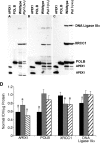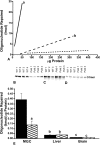Mutagenesis is elevated in male germ cells obtained from DNA polymerase-beta heterozygous mice
- PMID: 18650495
- PMCID: PMC2679517
- DOI: 10.1095/biolreprod.108.069104
Mutagenesis is elevated in male germ cells obtained from DNA polymerase-beta heterozygous mice
Abstract
Gametes carry the DNA that will direct the development of the next generation. By compromising genetic integrity, DNA damage and mutagenesis threaten the ability of gametes to fulfill their biological function. DNA repair pathways function in germ cells and serve to ameliorate much DNA damage and prevent mutagenesis. High base excision repair (BER) activity is documented for spermatogenic cells. DNA polymerase-beta (POLB) is required for the short-patch BER pathway. Because mice homozygous null for the Polb gene die soon after birth, mice heterozygous for Polb were used to examine the extent to which POLB contributes to maintaining spermatogenic genomic integrity in vivo. POLB protein levels were reduced only in mixed spermatogenic cells. In vitro short-patch BER activity assays revealed that spermatogenic cell nuclear extracts obtained from Polb heterozygous mice had one third the BER activity of age-matched control mice. Polb heterozygosity had no effect on the BER activities of somatic tissues tested. The Polb heterozygous mouse line was crossed with the lacI transgenic Big Blue mouse line to assess mutant frequency. The spontaneous mutant frequency for mixed spermatogenic cells prepared from Polb heterozygous mice was 2-fold greater than that of wild-type controls, but no significant effect was found among the somatic tissues tested. These results demonstrate that normal POLB abundance is necessary for normal BER activity, which is critical in maintaining a low germline mutant frequency. Notably, spermatogenic cells respond differently than somatic cells to Polb haploinsufficiency.
Figures




Similar articles
-
Base excision repair is limited by different proteins in male germ cell nuclear extracts prepared from young and old mice.Mol Cell Biol. 2002 Apr;22(7):2410-8. doi: 10.1128/MCB.22.7.2410-2418.2002. Mol Cell Biol. 2002. PMID: 11884623 Free PMC article.
-
Age-related instability in spermatogenic cell nuclear and mitochondrial DNA obtained from Apex1 heterozygous mice.Mol Reprod Dev. 2011 Dec;78(12):906-19. doi: 10.1002/mrd.21374. Epub 2011 Sep 14. Mol Reprod Dev. 2011. PMID: 21919107 Free PMC article.
-
Spontaneous mutagenesis is enhanced in Apex heterozygous mice.Mol Cell Biol. 2004 Sep;24(18):8145-53. doi: 10.1128/MCB.24.18.8145-8153.2004. Mol Cell Biol. 2004. PMID: 15340075 Free PMC article.
-
Mammalian DNA beta-polymerase in base excision repair of alkylation damage.Prog Nucleic Acid Res Mol Biol. 2001;68:57-74. doi: 10.1016/s0079-6603(01)68090-5. Prog Nucleic Acid Res Mol Biol. 2001. PMID: 11554313 Review.
-
Variant base excision repair proteins: contributors to genomic instability.Semin Cancer Biol. 2010 Oct;20(5):320-8. doi: 10.1016/j.semcancer.2010.10.010. Epub 2010 Oct 16. Semin Cancer Biol. 2010. PMID: 20955798 Free PMC article. Review.
Cited by
-
Increased human AP endonuclease 1 level confers protection against the paternal age effect in mice.Mutat Res. 2015 Sep;779:124-33. doi: 10.1016/j.mrfmmm.2015.06.008. Epub 2015 Jun 20. Mutat Res. 2015. PMID: 26201249 Free PMC article.
-
Haploinsufficiency in mouse models of DNA repair deficiency: modifiers of penetrance.Cell Mol Life Sci. 2012 Mar;69(5):727-40. doi: 10.1007/s00018-011-0839-7. Epub 2011 Sep 28. Cell Mol Life Sci. 2012. PMID: 21952828 Free PMC article. Review.
-
Ionizing radiation-induced mutant frequencies increase transiently in male germ cells of older mice.Mutat Res. 2012 May 15;744(2):135-9. doi: 10.1016/j.mrgentox.2012.01.003. Epub 2012 Jan 31. Mutat Res. 2012. PMID: 22314132 Free PMC article.
-
Folate and colorectal cancer in rodents: a model of DNA repair deficiency.J Oncol. 2012;2012:105949. doi: 10.1155/2012/105949. Epub 2012 Oct 9. J Oncol. 2012. PMID: 23093960 Free PMC article.
-
BAX and tumor suppressor TRP53 are important in regulating mutagenesis in spermatogenic cells in mice.Biol Reprod. 2010 Dec;83(6):979-87. doi: 10.1095/biolreprod.110.085415. Epub 2010 Aug 25. Biol Reprod. 2010. PMID: 20739667 Free PMC article.
References
-
- Norbury CJ, Hickson ID.Cellular responses to DNA damage. Annu Rev Pharmacol Toxicol 2001; 41: 367–401.. - PubMed
-
- Wood RD.DNA repair in eukaryotes. Annu Rev Biochem 1996; 65: 135–167.. - PubMed
-
- Nielsen H, Krokan HE.Base excision repair in a network of defense and tolerance. Carcinogenesis 2001; 22: 987–998.. - PubMed
-
- Lindahl T, Wood RD.Quality control by DNA repair. Science 1999; 286: 1897–1905.. - PubMed
-
- Lindahl T.Suppression of spontaneous mutagenesis in human cells by DNA base excision-repair. Mutat Res 2000; 462: 129–135.. - PubMed
Publication types
MeSH terms
Substances
Grants and funding
LinkOut - more resources
Full Text Sources
Molecular Biology Databases
Research Materials
Miscellaneous

